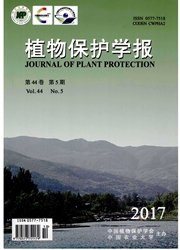

 中文摘要:
中文摘要:
为了比较2个转cry1Ab基因抗虫籼稻品系B1和B6对其非靶标害虫白背飞虱敏感性与其非转基因亲本对照嘉早935的差异,采用历期测定和产卵行为电子记录等方法分别测定了白背飞虱于B1和B6及嘉早935上的发育历期、产卵行为及繁殖力。结果表明,该飞虱以B1和B6为食时,其雌雄若虫总发育历期均显著长于对照,其中在B1上各延长了1.3和1.5天,B6延长了2.0和1.4天。产卵行为的电子记录结果表明,该飞虱在B1和B6上的产卵频次、一次产卵时间及总产卵时间与对照相比均无显著差异。在寄主植株可选择时,该飞虱有偏爱于B1上产卵,其上的产卵痕数、卵块数和总产卵量明显多于对照;而不嗜好于B6上产卵,其上的卵块及其卵粒数、总产卵量明显少于对照。然而,在寄主植株不可选择时,则未观察到这种差异。就卵孵化率而言,不论在寄主可选择还是不可选择时,与对照相比B1和B6对其均无显著的不利影响。
 英文摘要:
英文摘要:
To compare the susceptibility of two homogenous genotypes of transgenic indica rice, namely, B1 and B6 expressing a gene of cryl Ab from Bacillus thuringiensis Berliner against the non-target pest, the white-backed planthopper, Sogatella furcifera (Horvath), with that of their non-transgenic parental cuhivar (Jiazao 935), the development duration, oviposition behavior and fecundity of this planthopper on B1 and B6 were measured as compared with those on Jiazao 935 using the methods including a developmental duration measurement, an electronic monitor of the oviposition behavior. The results showed that total developmental time of female and male nymphs were significantly longer on both B1 and B6 than that on the control Jiazao 935, and were increased by 1.3 and 1.5 days for female and male nymphs on B1 and by 2.0 and 1.4 days on B6, respectively. There were no significant differences in the oviposition frequency, the duration per oviposition and total oviposition period among B1, B6 and the control by electronic monitoring system. Under the choice test, the female adults seemingly preferred to lay more eggs on B1 plants rather than on the control, resulting in that more numbers of oviposition scars and egg mass as well as total number of eggs laid were encountered to B1. In contrast, they apparently abstained from laying eggs on B6 plants by comparison with the control, resulting in that less numbers of egg mass and eggs per egg mass as well as total number of eggs laid were observed on B6. However, these significant differences were not found under no-choice test of these plants. As regard to hatching rate, B1 and B6 did not show any obvious adverse effect on it by comparison with the control under either choice or no choice test.
 同期刊论文项目
同期刊论文项目
 同项目期刊论文
同项目期刊论文
 期刊信息
期刊信息
